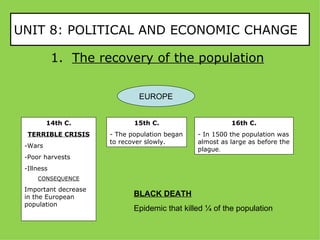
Unit 8 political and economic change
- 1. UNIT 8: POLITICAL AND ECONOMIC CHANGE 1. The recovery of the population EUROPE 14th C. 15th C. 16th C. TERRIBLE CRISIS - The population began - In 1500 the population was to recover slowly. almost as large as before the -Wars plague. -Poor harvests -Illness CONSEQUENCE Important decrease in the European BLACK DEATH population Epidemic that killed ¼ of the population
- 2. 2. Economic growth ECONOMIC EXPANSION WHERE WHEN C Europe REASONS 15th & 16th C. Better harvests Less wars End of Black Death Less deaths Banking system improved Greater demand for agricultural products CITIES: Centre of trade and crafts
- 3. 3. Social classes -Most privileged classes. - Minority but increasing -Did not pay direct taxes. -Most important positiions. NOBLES + CLERGY -Rich / powerful merchants - Some married into noble families to raise political power -Banking families BOURGEOISIE -Lived under harsh conditions PEASANTS -Became freemen
- 4. 4. Authoritarian monarchies • 15th C: Monarchs continued to reinforce their power by reducing the power of the nobility. HOW? Authoritarian Monarchies - They created a bureaucracy and professional administration. - Thy built up an army. Troops were paid. - They increased taxes to finance their activities. - Thy created a diplomatic system to maintain relations with other countries. • Consequence: Serious confrontations between monarchs and nobles= Civil Wars.
- 5. 5. The great kingdoms • In the Middle Ages, Europe was divided into many small states. But in the 15th c. many states began to be united by marriage alliances and by conquest. Great new powers were created. • Authoriatarian monarchies: Four great kingdoms. 1. FRANCE 2. ENGLAND 3. SPAIN: The Catholic Monarchs unified all the Iberian kingdoms, except Portugal. 4. RUSSIA
- 7. 6. What were the Spanish kingdoms? Castile and Aragón in the 15th century In the first half of the 15th century, the Iberian Peninsula was divided into five large Christian Kingdoms: • the Crown of Castile • the Crown of Aragón • the Kingdom of Navarre • the Kingdom of Portugal • the Islamic kingdom of Granada (1492:fell into the Catholic Monarchs) • The Crown of Castile: it was marked by continuos revolts against nobles. When the king died,Henry the IV, in 1474, the Castilians were divided between Henry`s daughter (Joanna La Beltraneja) and Henry´s sister (Isabella). Finally, Isabella was proclaimed Queen of Castile after 5 years of civil war (War of Succession). • The Crown of Aragón: the king, Martin I, died without heirs. In 1412, Ferdinand of Antequera, of the Trastamara dynasty, was named king. (This dynasty had governed Castile since the previous century).
- 8. Henry IV Isabella Joanna “La Beltraneja”
- 9. 7. Dynastic Union • In 1469, Ferdinand, son of the kinf of Aragón, married Isabella, sister of the king of Castile. In 1477, Isabella became Queen of Castile, and two yeras later, Ferdinad became King of Aragón. The Crwon of Castile and Aragón were united. • Isabella and Ferdinand, the Catholic Monarchs, governed their territories together, although its kingdom had its own laws and institutions. • After Isabella´s death in 1504, the throne of Castile passed to her daughter, Joanna The Mad, and Ferdinad, her father, continued as king of Aragón. • Joanna´s insanity prevented her from occupying the throne, and Ferdinand became regent until Charles I, Joannas´s son, took over both Crowns in 1516. • The dynastic union was finally confirmed in the person of Charles I and his successors. (Joanna`s husband, Felipe el Hermoso, tried to convienced people of Joanna´s madness because he was interested in the throne).
- 10. Fernando Isabella King of Aragón Queen of Castile Isabella and Fernando The Catholic Monarchs
- 11. A Palace in Zaragoza
- 13. Joanna “ The Mad” Philip “The Handsome”
- 14. 8. How did the Catholic Monarchs rule? Domestic policies • Peace was set out after the War of Succession ended. • The Catholic Monarchs, Isabella and Ferdinad, created the Holy Brotherhood, a judicial police force to fight against the bandits and the abuses of the nobility. • They also strengthened the Royal Council, the highest judicial body. • They appointed corregidores to establish royal authority in the towns. • They strengthened the royal Treasury and took provileges away from the nobles. • They also created a permanent , professional army, which became one of the best in Europe.
- 16. Territorial expansion • The Catholic Monarchs expanded their territories. In 1492, they conquered the Kingdom of Granada, and annexed it to the Crown of Castile. • They annexed other territories such as: the Kingdom of Navarre, the Kingdom of Naples, Melilla and Oran, the Canary Islands and began the conquest of the Americas. Religious unity • The Catholic Monarchs wanted religious unification for their kingdoms. In 1478, with the Pope`s permission, they founded the Tribunal of the Inquisition to prosecute heretics ( a person who committed herery: controversial change to a religion against the established dogma). The tribunal was known for its sever sentences and punishments. • They also expelled the Jews in 1492. by royal decree to convert to Christianity or leave Spain. The conversors, or converts, were persecuted by the Inquisition. • In 1512, a similar decree established the conversion or expulsion of Mudejars, or Spanish Muslims. Muslims who converted to Christianity were called Moriscos.
